Product Images Quetiapine Fumarate
View Photos of Packaging, Labels & Appearance
Product Label Images
The following 31 images provide visual information about the product associated with Quetiapine Fumarate NDC 51407-074 by Golden State Medical Supply, Inc., such as packaging, labeling, and the appearance of the drug itself. This resource could be helpful for medical professionals, pharmacists, and patients seeking to verify medication information and ensure they have the correct product.
51407 073 60LB
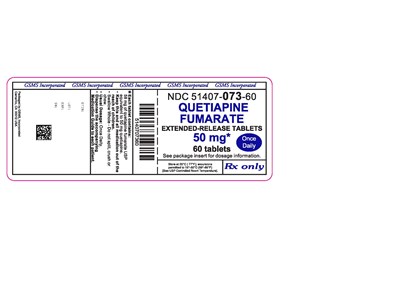
This is a medication package containing 60 tablets of 50 mg each, with an active ingredient of quetiapine fumarate. The usual dosage is once daily and patients should swallow the tablet whole and not split, crush or chew it. The safe storage temperature is between 15°C to 30°C (59°F - 86°F). The package comes with a medication guide for patients, and caution should be taken to keep the medication out of reach of children. The pack was packaged by GS8MS, Incorporated in California, USA.*
51407 075 60OL
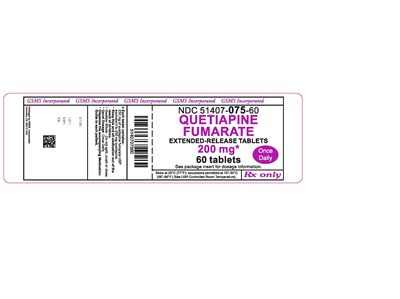
This is a medication with NDC 51407-075-60 that contains Quetiapine Fumarate Extended-Release Tablets with a strength of 200 mg, provided in a package of 60 tablets, for daily use. Dosage information can be found in the package insert. It should be stored at 25°C (77°F) with excursions allowed between 15°-30°C (59°-86°F) as per USP Controlled Room Temperature. The rest of the text is not readable.*
51407 076 60OL

The text is a medication label containing information about the drug Quetiapine Fumarate, which is an extended-release tablet medication that comes in a bottle of 60 tablets, each containing 300mg. The label provides storage information, dosage instructions, and identification numbers. Additionally, there are some unreadable characters towards the end of the text.*
51407 077 60OL
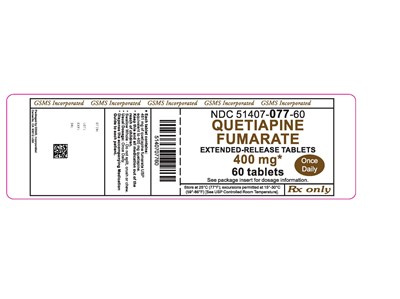
This is a medication package for Quetiapine Fumarate Extended-Release Tablets with a strength of 400 mg. It contains 60 tablets for oral use only. Dosage information is provided in the package insert. The storage temperature is recommended to be at 25°C (77°F) with permitted excursions between 15°-30°C (59°-86°F). The rest of the text is not readable and contains a mix of special characters and non-English language, so it's not available.*
b3b6f495 0ca0 46ba bd62 70d1f43faf6b 01
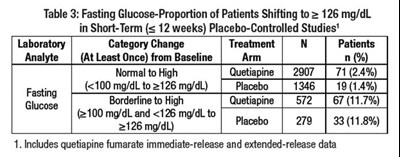
Table 3 displays the proportion of patients whose fasting glucose levels shifted from normal or borderline to high (greater than 126mg/dL) after short-term (less than 12 weeks) treatment with Quetiapine or Placebo. The data shows that in the Quetiapine group, 2.4% shifted from normal to high, while 11.7% shifted from borderline to high. In comparison, only 1.4% and 11.8% shifted in Placebo group, respectively. The table includes data from both immediate-release and extended-release Quetiapine formulations.*
b3b6f495 0ca0 46ba bd62 70d1f43faf6b 02
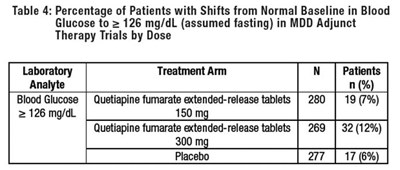
This is a table that shows the percentage of patients who had blood glucose shifts from a normal baseline to 126 mg/dL or higher, assuming fasting, during MDD adjunct therapy trials by dose. The table displays the laboratory treatment arm, the number of patients in each arm, and the number and percentage of patients who experienced blood glucose shifts. The three arms included in the table are Quetiapine fumarate extended-release tablets in 150 mg and 300 mg doses, and placebo.*
b3b6f495 0ca0 46ba bd62 70d1f43faf6b 03
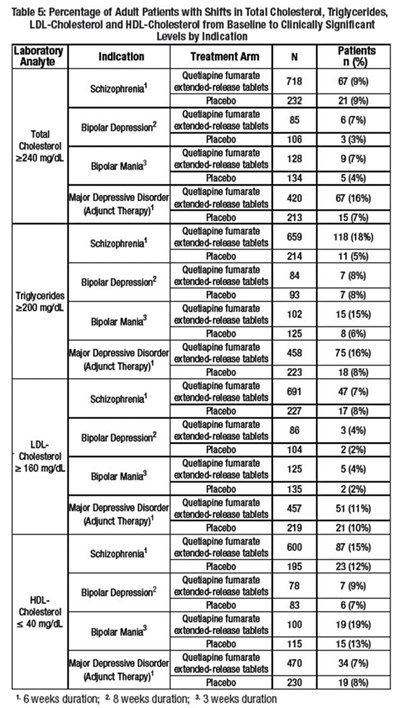
The text appears to be a table showing the percentage of adult patients with shifts in total cholesterol, triglycerides, LDL-cholesterol, and HDL-cholesterol from baseline to clinically significant levels by indication and treatment arm. The indications include bipolar depression, bipolar mania, major depressive disorder, schizophrenia, and adjunct therapy. The treatment arms include Quetiapine fumarate and Placebo for extended-release tablets. The table has information about the number of patients (n) and the percentage of patients with shifts for each indication and treatment arm. The duration of treatment varies from 3 to 8 weeks.*
b3b6f495 0ca0 46ba bd62 70d1f43faf6b 04
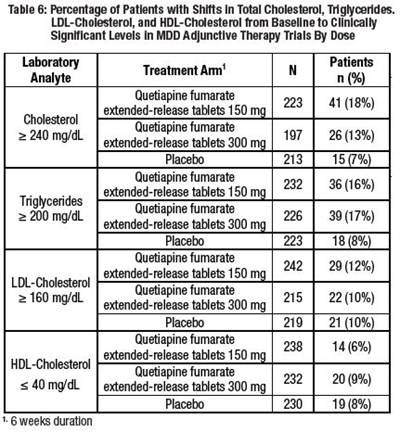
This is a table with data showing the percentage of patients whose total cholesterol, triglycerides, LDL-cholesterol, and HDL-cholesterol levels have shifted to clinically significant levels from baseline in major depressive disorder (MDD) adjunctive therapy trials by dose over a 6-week duration. The data include patients who were given different doses of Quetiapine Fumarate extended-release tablets, Quetiapine Fumarate prolonged-release tablets, and Placebo.*
b3b6f495 0ca0 46ba bd62 70d1f43faf6b 06
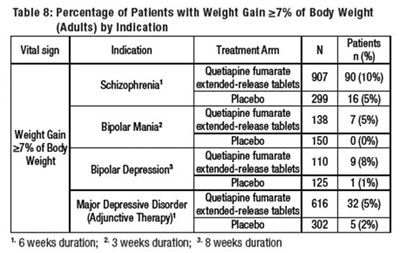
Table 8 shows the percentage of adult patients with weight gain greater than 7% of body weight by indication and treatment. The table includes information such as the indication, treatment, number of patients, and percentage of weight gain. For example, for schizophrenia patients treated with Quetiapine fumarate extended-release tablets, 7 out of 90 patients (10%) experienced weight gain greater than 7% of their body weight, while 299 out of 306 patients (98%) treated with the placebo did not experience such weight gain. The duration of the trials varied between 6, 3, and 8 weeks.*
b3b6f495 0ca0 46ba bd62 70d1f43faf6b 07

Table 9 shows the percentage of patients with weight gain equal to or greater than 7% of their body weight in MDD Adjunctive Therapy Trials for adults, categorized by dose and treatment arm. The table lists the number of patients observed and the percentage of weight gain for each treatment arm. The Quetiapine fumarate extended-release tablets at both 150 mg and 300 mg doses showed weight gain of 3% and 7%, respectively. The placebo had a weight gain of 2% with a total of 302 observations.*
b3b6f495 0ca0 46ba bd62 70d1f43faf6b 09

This is a table presenting the incidence of shifts in thyroid hormone levels and TSH in short-term placebo-controlled clinical trials for Quetiapine. The table includes data for total T, free T, total Ty, free T, and TSH. The shifts are defined as <0.8 x LLN (pmoVL) for total T, free T, total T, and free T and >5 miWL for TSH at any time post-baseline. The table includes data for both Quetiapine and Placebo and includes both Quetiapine fumarate tablets and Quetiapine fumarate extended-release tablet data.*
b3b6f495 0ca0 46ba bd62 70d1f43faf6b 10

This is a table presenting the adverse reactions associated with extrapyramidal symptoms in a clinical trial for bipolar mania comparing the drug quetiapine fumarate to a placebo. The table lists the number and percentage of patients who experienced different types of extrapyramidal events such as dystonic event, Parkinsonism, Akathisia, and other extrapyramidal events. There were no adverse reactions with the preferred term of dyskinetic event.*
b3b6f495 0ca0 46ba bd62 70d1f43faf6b 11

This is a table showing adverse reactions associated with extrapyramidal symptoms in a clinical trial for bipolar depression. The trial was placebo-controlled and involved the use of quetiapine fumarate tablets. The table lists the percentage of patients who experienced various extrapyramidal symptoms such as dystonia, Parkinsonism, and akathisia. There were no adverse reactions with the preferred term of dyskinetic event.*
b3b6f495 0ca0 46ba bd62 70d1f43faf6b 12
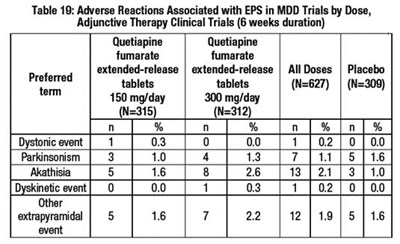
This appears to be a table showing the adverse actions associated with the use of Quetiapine Fumarate in adjunctive therapy clinical trials for Major Depressive Disorder (MDD), with varying doses and duration of treatment. The adverse actions listed include dystonic event, Parkinsonism, Akathisia, Dyskinesic event, and Other extrapyramidal events. The percentage of participants who experienced each adverse action is also listed.*
b3b6f495 0ca0 46ba bd62 70d1f43faf6b 13
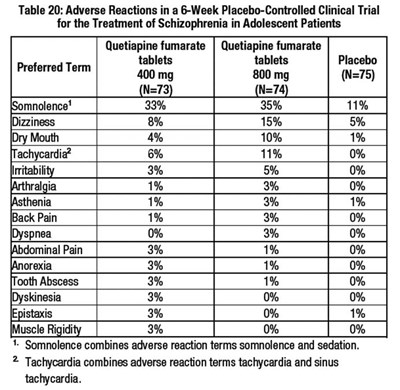
This is a table showing adverse reactions in a 6-week placebo-controlled clinical trial for the treatment of schizophrenia in adolescent patients with Quetiapine fumarate tablets. The table includes the adverse reactions percentages for each group, Proforred Term 400 mg, 800 mg (N=75) and Placebo (N=74). The adverse reactions listed are Somnolence, Dizziness, Dry Mouth, Tachycardia, Irritability, Arthralgia, Asthenia, Back Pain, Dyspnea, Abdominal Pain, Anorexia, Tooth Abscess, Dyskinesia, Epistaxis, and Muscle Rigidity.*
b3b6f495 0ca0 46ba bd62 70d1f43faf6b 14
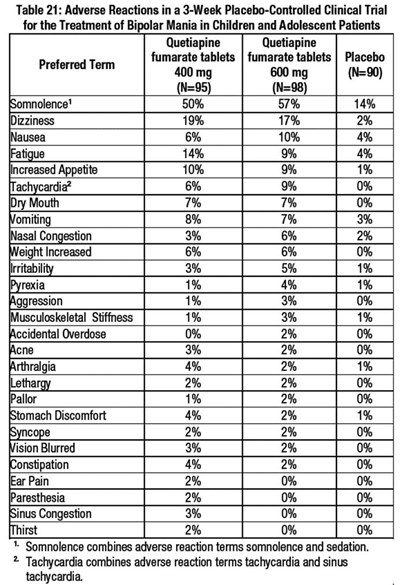
This is a table displaying the adverse reactions observed in pediatric patients suffering from bipolar mania during a 3-week placebo-controlled clinical trial for the treatment of the same. The drugs taken during this trial were Quetiapine and Quetiapine Fumarate tablets. The table displays a preferred term, dosage, and the percentage of patients who experienced adverse reactions from the drug. The adverse reactions include sleepiness, dizziness, nausea, fatigue, increased appetite, dry mouth, weight increase, among others.*
b3b6f495 0ca0 46ba bd62 70d1f43faf6b 15
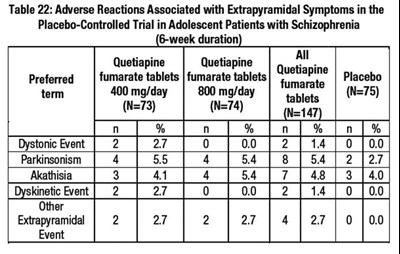
This is a table of statistics regarding adverse reactions associated with extrapyramidal symptoms in a placebo-controlled trial of adolescent patients with schizophrenia who were given Quetiapine Fumarate Tablets. The trial lasted 6 weeks, and varying doses of the tablets were given to different groups of patients. Adverse reactions noted in the table include dystonic event, Parkinsonism, akathisia, dyskinetic event, and other extrapyramidal events.*
b3b6f495 0ca0 46ba bd62 70d1f43faf6b 16
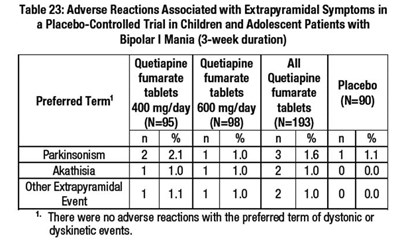
This is a table showing the adverse reactions associated with extrapyramidal symptoms in a placebo-controlled trial in children and adolescent patients with bipolar mania that lasted 3 weeks. The table compares the outcomes of patients taking Quetiapine fumarate tablets (at 400mg/day and 600mg/day) and Quetiapine all preferred term tablets to those taking a placebo, with percentages of patients affected by Parkinsonism, akathisia, and other extrapyramidal events. The text indicates that there were no adverse reactions with the preferred term of dystonic or dyskinetic events.*
b3b6f495 0ca0 46ba bd62 70d1f43faf6b 18
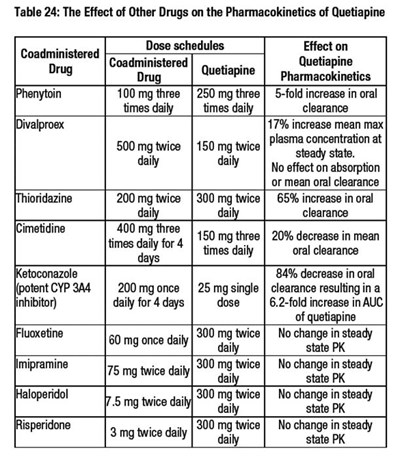
The provided text describes a table showing the effect of different drugs on the pharmacokinetics of Quetiapine, a medication used to treat schizophrenia and bipolar disorder. The table lists the co-administered drug, the dose schedules, and the corresponding effects on Quetiapine. These effects include changes in oral clearance, absorption, maximum concentration, and area under the curve. Some drugs, such as Phenobarbital and Ketoconazole, have a significant impact on Quetiapine, while others, such as Fluoxetine, Imipramine, and Haloperidol, have no significant effect.*
b3b6f495 0ca0 46ba bd62 70d1f43faf6b 19
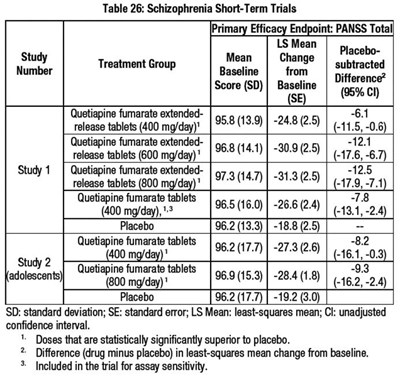
This is a table presenting results from short-term trials for the treatment of schizophrenia. The primary efficacy endpoint is PANSS Total. The table compares the LS Mean baseline score, mean change, and difference for different treatment groups, including Quetiapine fumarate extended-release tablets and placebo. Standard deviation, standard error, and unadjusted confidence intervals are also provided. Doses that are statistically significantly superior to placebo are indicated. Study 1 included Quetiapine fumarate extended-release tablets at 800 mg/day. Study 2 included adolescents and Quetiapine fumarate tablets for assay sensitivity.*
b3b6f495 0ca0 46ba bd62 70d1f43faf6b 20
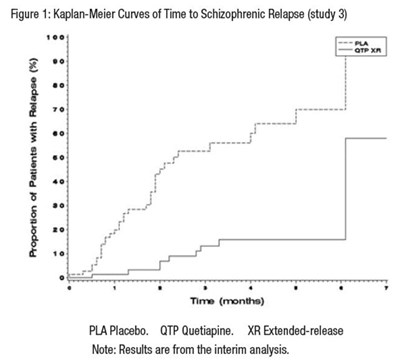
The text describes a figure labeled "Figure 1" showing Kaplan-Meier curves indicating the time to relapse in a study of schizophrenia. The figure includes curves labeled PLA, QTP, and XR, showing the proportion of patients with relapse over time in each treatment group. The results are based on an interim analysis.*
b3b6f495 0ca0 46ba bd62 70d1f43faf6b 21
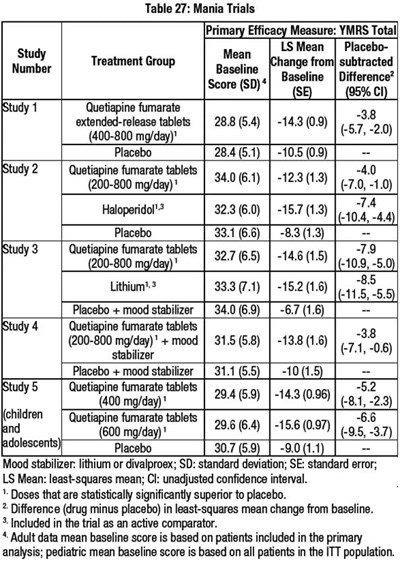
Table 27 shows the results of five mania trials. The primary efficacy measure, YMRS Total score, is reported along with the mean LS Mean, baseline score, changes from baseline, placebo scores, and differences (drug minus placebo) in least-squares mean change from baseline. The trials tested the effectiveness of Quetiapine fumarate tablets and extended-release tablets, haloperidol, lithium, and divalproex. The table also notes that standard deviation (SD) and standard error (SE) were used and that Cl refers to unadjusted confidence intervals. The text also notes that the mean baseline score in adult trials was based on patients included in the primary analysis, while the pediatric mean baseline score includes all patients in the ITT population.*
b3b6f495 0ca0 46ba bd62 70d1f43faf6b 22

The text describes a table (Table 28) that shows the results of a study on depressive episodes associated with bipolar disorder. The primary efficacy measure used is MADRS Total. The table lists the mean, LSMean, and standard deviation of the baseline score as well as the change from baseline for each treatment group. The treatment groups include a placebo group, two groups receiving different doses of quetiapine fumarate (300 mg/day and 600 mg/day), and a group receiving extended-release tablets of quetiapine fumarate (300 mg/day). The table also displays the statistically significant differences between the drug and placebo in terms of least-squares mean change from baseline.*
b3b6f495 0ca0 46ba bd62 70d1f43faf6b 25
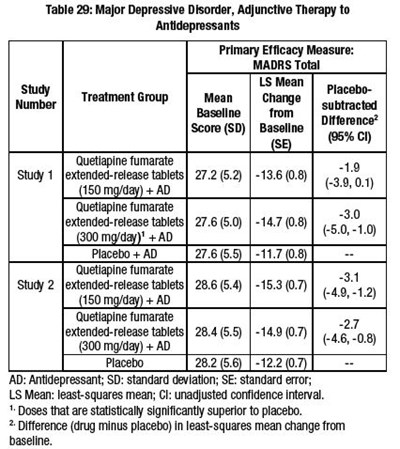
The text appears to be a table presenting data on the efficacy of adjunctive therapy to antidepressants for major depressive disorder. The primary efficacy measure is the MADRS total score. The table compares the baseline and subtracted scores for different treatment groups, including Quetiapine marate, Quetiapine fumarate, and a placebo group. The table also provides information on SD, SE, LS Mean, and confidence intervals. Doses that are statistically superior to placebo are indicated.*
* The product label images have been analyzed using a combination of traditional computing and machine learning techniques. It should be noted that the descriptions provided may not be entirely accurate as they are experimental in nature. Use the information in this page at your own discretion and risk.






